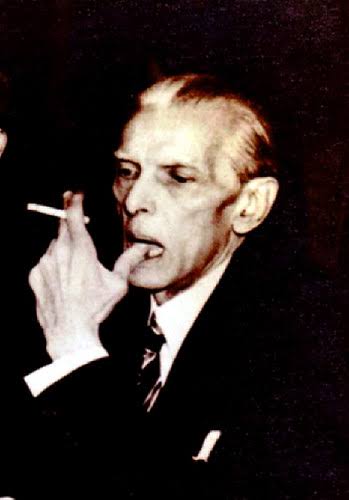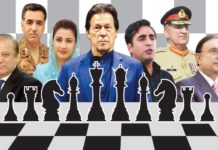The picture of the Quaid-e-Azam hanging in my room is of a clean shaved Jinnah, he is wearing a three piece suit and holding a cigar in his hand, however a friend of mine wants me to change the picture of the Quaid and replace it Sherwani (Long coat-like garment worn in the Indian subcontinent) and Jinnah cap, not only that, but I should also “snatch” a cigar from his hand, draw a beard on his face and write “Maulvi Muhammad Ali Jinnah” below. This desire is not only of my friend but of every person who wants to implement his own system in this country instead of the vision of the Quaid, and the good news is that this friend is a follower of those who genuinely opposed the establishment of Pakistan and labeled the Quaid-e-Azam “Kafir-e-Azam”.
The man we know as Quaid-e-Azam Muhammad Ali Jinnah joined Lincoln Inn as Muhammad Ali Jinnah Bhai, but later requested that his name be changed to “MA Jinnah” or “Muhammad Ali Jinnah”. However, the name was later changed to MA Jinnah .
Once Jinnah was employed as a stage artist at the Shakespeare Theater Company in London, his father wrote him a letter: “Do not be a traitor of the family” , after this letter, he quit his job.
In 1918, Quaid-e-Azam married Rati, the daughter of Sir Dinshaw Petit. This marriage of Quaid-e-Azam was a love marriage which took place without the consent and intention of Rati’s parents . Quaid-e-Azam admitted his sister Fatima Jinnah to a co-educational institution in Mumbai despite opposition from Muslims. .
The Quaid-e-Azam wore a three-piece suit, with a tie, shaved every day, smoked a cigar, kept his capital in a bank, made a profit on it and invested in the stock market .
Maulvi Muhammad Ali Jinnah used to idealize Kamal Ataturk who was completely secular and liberal. In his speech in Patna on October 27, 1937, Quaid-e-Azam said, “I wish I was Mustafa Kamal. [” Iqbal, Lahore, p. 172], on the demise of Kamal Ataturk, the Quaid-e-Azam called on the supporters of the Muslim League to observe a day of mourning.
Addressing the Central Legislative Assembly on February 7, 1935, Maulvi Jinnah said, “Religion should not be included in politics. Religion is a matter between God and man.”.
Later, Maulvi Sahib, while addressing the students of Aligarh University on February 5, 1938, said, “(Muslim League) has liberated you from the reactionary elements of Muslims and the unpopular narrative of Maulvis and Maulanas.” .
Beverly Nichols writes in his famous book “The verdict of India” that Jinnah told him that the case of Muslims can be described in five sentences, Muslims are a nation No. 1, in terms of its history, No. 2, According to its heroes, No. 3, in the light of its art and architecture, No. 4, in terms of music, No. 5, according to the rules which are different from the Hindus. The author asked, what is his opinion about the differences regarding religion? Jinnah replied. “Partially but not completely” .
The majority of religious scholars in India were against the Muslim League and Pakistan. The President of the Jamiat Ulema-i-Hind, Maulana Hussain Ahmad Madani, issued a fatwa on the eve of the October 1945 elections that joining the Muslim League was forbidden. .
Majlis-e-Ahrar strongly opposed Pakistan. Ahrar leader Maulana Mazhar Ali called Quaid-e-Azam “Kafir-e-Azam” in one of his poems .
Jamaat-e-Islami also opposed the establishment of Pakistan, Maulana Maududi wrote that from the Quaid-e-Azam of the Muslim League to an ordinary worker does not know anything about Islam. They also do not know the meaning and significance of “Muslim”, .
Not a single minister in Pakistan’s first cabinet was a religious leader. Maulvi Jinnah did not even set up a religious ministry. Both of his military secretaries were British who worked with him until his death. The Chiefs of the Air Force were nominated by the British, the governors of the two provinces were also British while the 500 officers of the army and civil service were British, a Christian Diwan Bahadur SP Sangha was elected Speaker of the Punjab Assembly in 1946, after the formation of Pakistan. He was appointed to the same post.
When Quaid-e-Azam talked about making Pakistan a fortress of Islam, his idea was: “Another lofty goal of Pakistan is that it will be a foundation on which we will be able to educate Muslim intellectuals, train economists, scientists, doctors, engineers, technicians who can work for the revival of Islam, they will spread to the Middle East and other Muslim countries so that they can help their Muslim brothers and “The Middle East will become a strong bloc, a third bloc that will be neither communist nor capitalist but socialist.” .
Not a single religious figure was among the 24 politicians nominated by Quaid-e-Azam for the working committee of the All India Muslim League in 1947. .
During the rule of Quaid-e-Azam, cabinet meetings did not begin with recitation. According to the decision of the cabinet, the official hours of the offices were fixed from 10:00 am to 5:30 pm and no break was allowed for prayers. .
In August 1947, the government of Pakistan declared Friday a half holiday. When Gandhi was assassinated in January 1948, the Quaid-e-Azam, the Governor General of Pakistan, declared a public holiday in Gandhi’s mourning. 59].
Maulvi Jinnah, instead of visiting a mosque or mausoleum after assuming the office of Governor General, visited the Holy Trinity Church in Karachi on August 17, 1947, assuring non-Muslims that he considered them equal citizens of Pakistan.
All these things are in place but I don’t know why I am seriously thinking of changing the portrait of Quaid-e-Azam and putting a portrait of “Maulvi Muhammad Ali Jinnah” in its place. The soul of Quaid-e-Azam will surely be happy with my move.
Note: The facts in this column are taken from Qayyum Nizami’s book “Quaid-e-Azam as Governor General”.








